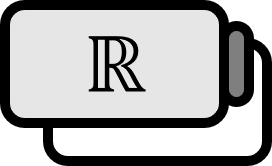Proof that Pi is an Irrational Number
Theorem
$$\pi \notin \mathbb{Q}$$
$\mathbb{Q}$ represents the set of rational numbers.
Proof
Strategy: Utilize the fact that integers do not have the property of being dense. Define the functions $f$, $F$ very cleverly, applying various tricks. This method was devised by Ivan Niven and is among the easiest to prove that $\pi$ is irrational, but unfortunately, because it employs the epsilon-delta argument, it cannot be proven within the scope of high school curriculum without leaps.
$\mathbb{N}$ represents the set of natural numbers, $\mathbb{Z}$ represents the set of integers.
Part 1. $f^{(j)} (0), f^{(j)} (\pi) \in \mathbb{Z}$
Assuming that $\pi \in \mathbb{Q}$, the pi $\pi$ should be expressible in terms of some relatively prime $a,b \in \mathbb{N}$ as $\pi = {{ a } \over {b}}$. Regarding this, let’s define the function $f$ as follows.
$$ f(x) := {{ x^{n} ( a - bx )^{n} } \over { n! }} $$ Then, $f(x)$ does not have terms of lower order than $n$, and since $a, b, n \in \mathbb{N}$, by the binomial theorem, all coefficients of terms in $n! f(x)$ are integers. Therefore, if $x = 0$, for all $j = 0, 1, 2, \cdots$
$$ f^{(j)} (0) \in \mathbb{Z} $$
Meanwhile, since $f(x) = f \left( {{ a } \over { b }} - x \right) = f( \pi - x)$
$$ f^{(j)} (\pi) \in \mathbb{Z} $$
Part 2. $\int_{0}^{\pi} f(x) \sin x dx \in \mathbb{Z}$
$$ F(x) := \sum_{j=0}^{n} ( -1 )^{j} f^{(2j)} (x) = f(x) - f ''(x) + f^{(4)} (x) - \cdots + (-1)^{n} f^{(2n)} (x) $$
Defining a new function $F$ for $f$ as above
$$ \begin{align*} {{ d } \over { dx }} \left[ F ' (x) \sin x - F(x) \cos x \right] =& F’’(x) \sin x + F(x) \sin x \\ =& \left[ - \sum_{j=1}^{n} ( -1 )^{j} f^{(2j)} (x) + \sum_{j=0}^{n} ( -1 )^{j} f^{(2j)} (x) \right] \sin x \\ =& f(x) \sin x \end{align*} $$
Conversely, integrating $f(x) \sin x$ from $[0,\pi]$ gives
$$ \begin{align*} \int_{0}^{\pi} f(x) \sin x dx =& \left[ F ' (x) \sin x - F(x) \cos x \right]_{0}^{\pi} \\ =& F( \pi ) + F( 0 ) \end{align*} $$
But since it was $f^{(j)} (0), f^{(j)} (\pi) \in \mathbb{Z}$ in Part 1, $F(0), F(\pi) \in \mathbb{Z}$ hence
$$ \left( F( 0 ) + F(\pi) \right) \in \mathbb{Z} $$
Part 3. $\int_{0}^{\pi} f(x) \sin x dx \in \mathbb{N}$
If we say $0 < x < \pi$ then
$$ \begin{align*} f(x) =& {{ x^{n} ( a - bx )^{n} } \over { n! }} \\ =& {{ b^{n} x^{n} \left( {{ a } \over { b }} - x \right)^{n} } \over { n! }} \\ =& {{ b^{n} x^{n} \left( \pi - x \right)^{n} } \over { n! }} \end{align*} $$
Hence $f(x) > 0$ and since $\sin x > 0$
$$ 0 < f(x) \sin x $$
Therefore, $\int_{0}^{\pi} f(x) \sin x dx \in \mathbb{Z}$ of Part 2. is actually
$$ \int_{0}^{\pi} f(x) \sin x dx \in \mathbb{N} $$
Part 4. $0 < f(x) \sin x < {{ \pi^{n} a^{n} } \over { n! }}$
Differentiating $f$ gives $$ \begin{align*} f '(x) =& {{ n x^{n-1} ( a - bx )^{n} } \over { n! }} - {{ b n x^{n} ( a - bx )^{n-1} } \over { n! }} \\ =& {{ x^{n-1} ( a - bx )^{n-1} } \over { (n-1) ! }} \left[ (a-bx) - bx \right] \\ =& 2b {{ x^{n-1} ( a - bx )^{n-1} } \over { (n-1) ! }} \left[ {{ \pi } \over {2}} - x \right] \end{align*} $$ Therefore, $f$ has its maximum value at $x = {{\pi} \over {2}}$. Directly substituting and calculating gives $$ \begin{align*} f(x) \le & {{ b^{n} } \over { n! }} \left( {{\pi} \over {2}} \right)^{n} \left( {{\pi} \over {2}} \right)^{n} \\ =& {{ a^{n} } \over { n! }} \left( {{1} \over {2}} \right)^{n} \left( {{\pi} \over {2}} \right)^{n} \\ =& {{ a^{n} } \over { n! }} \left( {{\pi} \over {4}} \right)^{n} \\ <& {{ a^{n} \pi^{n} } \over { n! }} \end{align*} $$ Of course, since from $0 < x < \pi$, $| \sin x | \le 1$, for all $n \in \mathbb{N}$ $$ 0 < f(x) \sin x < {{ (a \pi)^{n} } \over { n! }} = \lim_{n \to \infty} {{ (a \pi)^{n} } \over { n! }} = 0 $$ Therefore $$ n \ge N \implies \int_{0}^{\pi} f(x) \sin x dx < 1 $$ A $N \in \mathbb{N}$ satisfying this exists. However, this contradicts $\int_{0}^{\pi} f(x) \sin x dx \in \mathbb{N}$, leading to the following conclusion. $$ \pi \notin \mathbb{Q} $$
■
